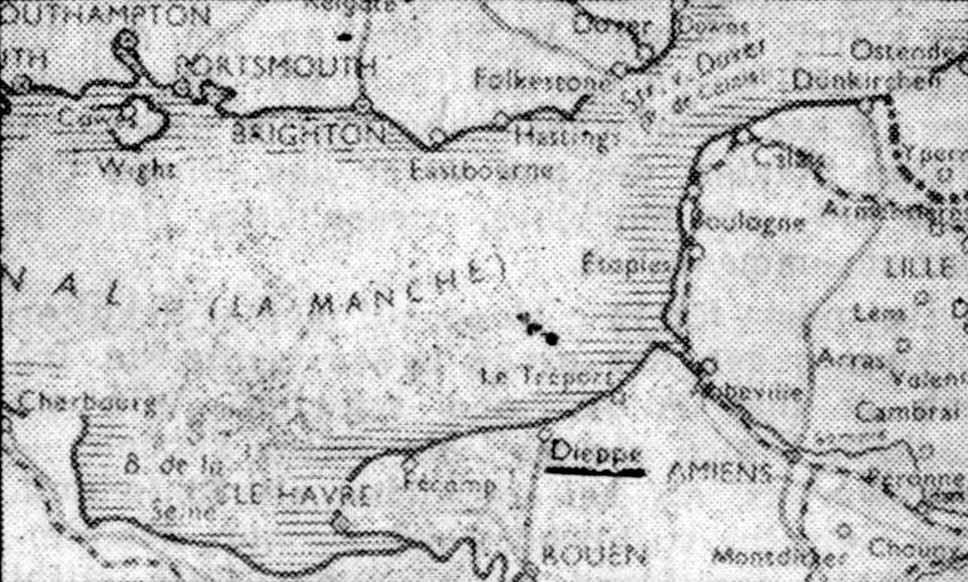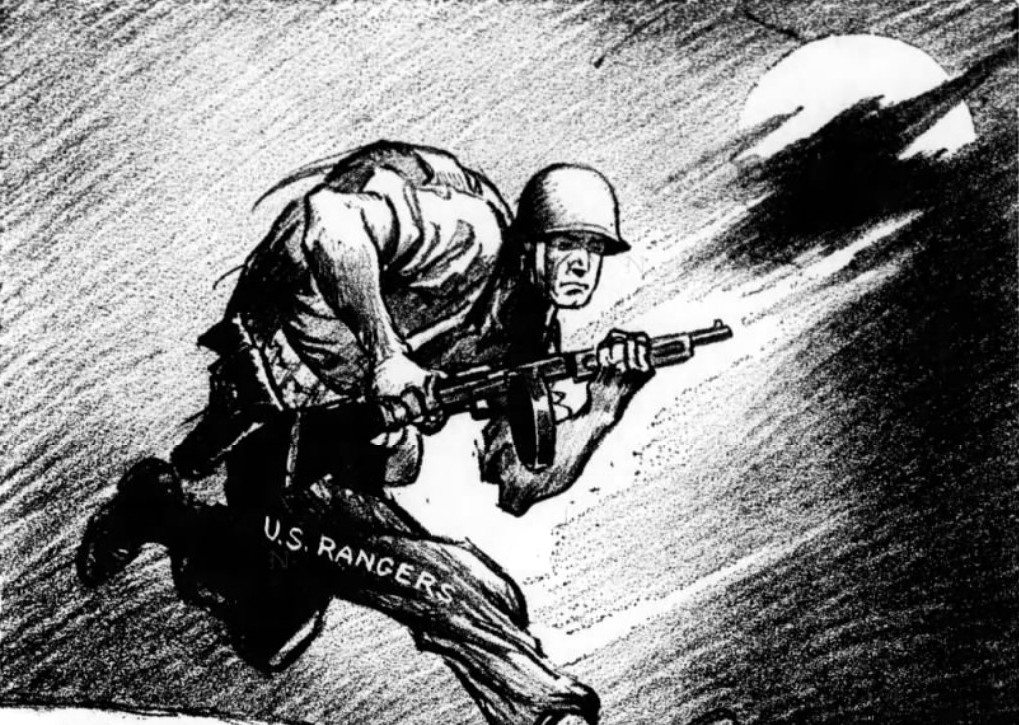Combined Operations HQ, Britain (August 19, 1942)
A raid was launched in the early hours of today on the Dieppe area of occupied France.
The occupation is still in progress and a further communiqué will be issued when fuller reports are available.
Meanwhile, the French people are being advised by wireless broadcasts that this raid is not an invasion.
The Gazette (August 19, 1942)
Occupied Dieppe area raided by Commandos
London, England (CP) –
The Commandos made a raid on the Dieppe area of occupied France early today, British headquarters announced.
The bulletin said the operation is still in progress.
Meanwhile, it added, the French people were being advised by radio the raid was not a full-fledged invasion.
The Combined Operations Headquarters communiqué said:
A raid was launched in the early hours of today on the Dieppe area of occupied France.
The occupation is still in progress and a further communiqué will be issued when fuller reports are available.
Meanwhile, the French people are being advised by wireless broadcasts that this raid is not an invasion.
Brooklyn Eagle (August 19, 1942)
U.S., BRITISH AIR, LAND FORCES RAID FRANCE
Tanks back up Commando units
Hitler gets foretaste of 2nd front on Dieppe coast – big guns razed
London, England (UP) –
American, British and Canadian troops today gave Adolf Hitler a foretaste of a second front in Europe with a record-breaking Commando attack on the Dieppe coast of France.
Operating under a cloud of Allied warplanes – American Flying Fortresses and American fighter squadrons among them – the Commandos smashed into the Nazi coastal defenses of the Dieppe sector.
At mid-afternoon London Time, the Commando attack was still in progress but some of the troops were being withdrawn – having achieved their objective, which was destruction of a big battery of six-inch Nazi coast defense guns and a munitions dump.
The English Channel coast shook under the reverberation of the battle – the greatest land and air operation which Western Europe had seen since the days of Dunkirk.
There was no indication how long the Commandos were prepared to hold their positions around Dieppe, but presumably until they had fully carried out their objectives.
The American forces in the big attack were units of the newly-organized Ranger force – the American equivalent of the British Commandos. These picked volunteers have been training for several months in raid tactics.
American air forces were backing up the RAF in providing an air curtain for the land troops. Great Flying Fortress bombers were blasting at Nazi strongpoints and communications lines for German reinforcements.
A German news agency report tonight said that “since Wednesday afternoon,” all British, American and Canadian Commandos have been driven out of the Dieppe area.
The report said that more than 1,000 prisoners were taken by German forces and that Commando losses in men and material were very high but could not yet be estimated accurately.
Squadrons from all frontline RAF fighter stations along the coast were in action in continuous attacks not only in the Dieppe area but over a wide region of Northern France. American fighter squadrons were flying wing-to-wing with the British in the attacks.
Late today, it was learned in reliable quarters that wounded Commandos from the Dieppe area were already arriving at southeast coast points.
Wounded reach England
Residents of a southeast coast town reported that a number of ambulances were moving into the dock areas which were blocked off from the public.
It was also revealed that some Commandos have returned from the Dieppe area to a British base and were described as being in “high spirits.”
Backed up by tanks and operating under a cloud of Allied fighter planes, the Commandos debouched on the flat Dieppe coastline in such force that constant radio warnings were issued to the French populace that:
This is no invasion.
American, British and Canadian troops swarmed over the defenses which Adolf Hitler has erected as a protection against a second front and after hours of fighting were reported to have achieved many of their objectives, including the destruction of a big battery of six-inch coast defense guns and a Nazi ammunition dump.
Part of force returns
For the first time, Combined Operations Headquarters issued bulletins on the progress of the battle. By midday, at least part of the Commando forces were being reembarked for the home voyage back across the English Channel, having successfully carried out their mission.
However, at many points, heavy fighting was in progress, particularly in the center of the operations zone, apparently around the seashore town of Dieppe, where the Commandos had the support of tanks.
The American contribution to the attack was a battalion of Rangers – picked volunteers trained in Commando tactics. Canada provided the bulk of the raiding force but regular British Commandos and Free French detachments also participated.
British public cheers
News of the attack touched off a thrill of anticipation among the British public where the first reaction – despite repeated official cautions – was that the long-awaited second front had finally been achieved. Newspapers sold like hotcakes.
The assault was by far the biggest ever undertaken by the Commandos and provided not only a devastating test of the defenses which a second-front expedition will encounter but a large-scale test of second-front tactics.
All weapons were employed in the assault. British naval forces transported the troops and backed them up with bombardment of shore installations. Bombing planes attacked known Nazi strongpoints and reinforcement communications lines.
For the Americans, the attack represented the first time that U.S. troops have set foot in France since World War I. It climaxed months of intensive preparation and training of volunteer specialists with British Commandos.
Communiqué No. 2 said:
The troops participating in the raid on the Dieppe area landed at all points selected.
Troops on the right flank, having achieved their objectives, which included complete destruction of a six-inch gun battery and an ammunition dump, have now been reembarked.
In the center, tanks were landed and heavy fighting is proceeding.
Hint ‘chutists in action
It was believed that parachutists took part.
In its communiqué announcing the participation of the Rangers, U.S. Army Headquarters emphasized that its task had been to choose among the men who crowded to volunteer for the most dangerous work in the Army.
They were put in training some time ago with Adm. Lord Louis Mountbatten’s Commandos.
The communiqué said:
These special task troops, in training at certain Commando depots somewhere in the United Kingdom, make up what is known as United States Ranger battalions.
Fairbanks a Commando
It was announced that United States officers of all fighting force branches have for some time been serving on the staff of Mountbatten, fighting cousin of King George VI.
Among them is Navy Lt. Douglas Fairbanks, the motion picture star, the communiqué said.


